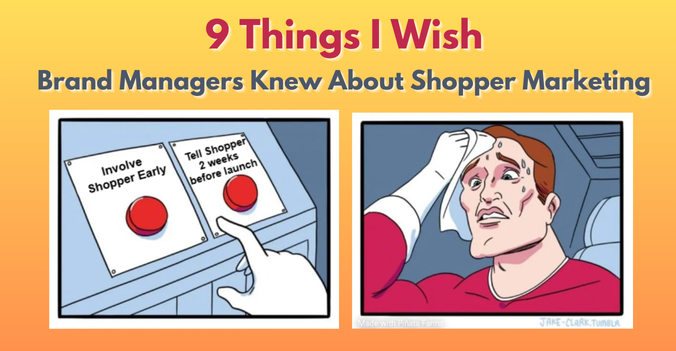The vast majority of CPG marketing teams use shopper incentives in the forms of coupons and rebates to enhance their shopper marketing campaigns. Despite the steady decrease in usage of traditional printed newspaper coupons, the popularity of digital coupons and rebates is on the rise due to several factors:
- Inflation that increase shopper demand for coupon discounts
- Generational shift where digitally-native Gen Zs are starting families and becoming interested in savings
- Retailers' new capabilities and pressure they apply on CPGs to fund their loyalty programs;
- New technologies and shopper tactics that enable better targeting and more efficient personalized offers.
Coupon spend makes up a significant part of CPG marketing spend, especially for food and beverage manufacturers, however, in working with CPG clients, I find that their incentive management process is often riddled with issues. Here are some examples, do they seem familiar?
Too Tactical
Incentive management is often viewed as too technical and tactical, rather than a strategic capability. Many marketers don’t understand the inner workings of the coupon offer creation, distribution, redemption handling and reconciliation because the work is delegated to a different department or a marketing agency and is rarely questioned.
Why does this matter? What is unknown cannot be optimized. Knowing the economics of the couponing industry, its major players, their business models and constraints will allow you to develop the most effective partnership strategies. You will be able to negotiate fair pricing, optimize offers to reach your ideal shoppers, with optimal frequency, and offer the right depth of discount. For large CPG organizations especially, an effective couponing process also means holistic, cross-functional alignment to avoid excessive “layering” and ensure that coupon offers work to strategically support trade promotions, national media and other marketing efforts undertaken by your colleagues.
Frustrating & Unpredictable
Managing variable coupon redemption spend is frustrating. Unlike insertion fees, media and in-store tactics where actual costs rarely surprise you, coupon redemption spend can vary significantly from its original forecast. Who is to blame? Poor forecasting model? A typo? A missed deadline? A competitor’s offer that was dropped right before your coupon went live? It’s hard to tell. That is why many CPGs don’t even attempt to forecast, let alone update and actualize their original coupon spend assumptions as part of their omnichannel marketing campaigns.
Why does this matter? Not tracking coupon redemptions for each campaign throughout the year and not properly actualizing each offer will inevitably lead to significant over- or underspend situations. The overspend is, of course, embarrassing, no marketer wants that reputation. But underspending is just as risky - good luck making a case to increase or keep your budget flat next year, why do you need the same level of funding if you couldn’t spend it?
Lacks Ownership
In an effort to streamline the coupon management process, many CPGs attempt to centralize it and create a single “redemption fund” for each brand, which various departments, such as Shopper, E-commerce, Retail Media and Consumer Promotions can bill against.
Why does this matter? This amorphous central redemption fund that everybody has access to but nobody is held accountable for results in poor forecasting and lack of visibility to marketers who design the incentive campaigns. Incorrect or missing coupon redemption costs can impair post-promotional measurement and inflate campaign ROIs.
Reported Incorrectly
Even the most rigorous coupon spend forecast and tracking process can be ineffective if the marketers don’t understand the importance of teasing out variable redemption costs from the rest of coupon program fees (fixed set up costs, insertion and handling fees). This is a complex task since depending on the coupon service provider (and most CPGs work with more than one), their business model will vary.
Why does this matter? This has to do with CPG Marketing legal compliance and ensuring your company doesn’t get in trouble during financial audits. Various kinds of coupon program spend affect different parts of the company’s P&L. Insertion and set up fees hit below the Net Sales line (a.k.a. “BTL”) while variable redemption cost hit the Trade Discounts, which sits above and reduces the Net Sales line (ATL).
Now What?
If you find any signs of dysfuctional incentive management, you will likely be interested in revamping the process. As you embark on this task, consider the following best practices:
- Standardize the process but decentralize budget ownership. Decentralization is a powerful tool to allow your team more agile decision making, for instance, shift funds to respond to retail customer needs, pre-empt competitive launch or or re-invest costs if the offer is under-redeeming. However, decentralization without guidance, standardization and oversight is a recipe for disaster. Partner with your finance and clearinghouse vendor to establish a common way to request, set up and track each offer performance, disburse redemption funds to each marketing desk and incentivise your marketing team for budget accuracy.
- Properly document coupon spend. Together with your finance partners, review coupon vendors’ and clearinghouse contract terms to create common nomenclature around coupon spend. Align on the expectations around reporting of various parts of coupon program components, such as set up fees, insertion fees, retailer handling fees, clearinghouse handling fees, redemption fees, etc. Review the basics of P&L management with your team and set expectations where each coupon spend component belongs on the P&L. Provide tools, examples and templates for how to plan and track coupon spend in a consistent manner across all desks.
- Continuously optimize incentive investment. Our experience shows that by managing coupons and rebates strategically increases ROI 2x. If your team has ownership of the couponing budget and regularly actualizes their offers, they will have the right inputs to do “fully loaded” campaign ROI measurement. They will be able to iterate to find what shopper targets, discount depth, purchase requirement, total circulation, as well as frequency yield best results. Note that overall redemption is just one factor, working with retailer’s shopper card data also allows you to track household metrics such as net new households attracted, share of wallet and purchase frequency among target shopper.
For help developing a seamless planning and reconciliation process for your omnichannel shopper marketing team, reach out to Shopperations. We offer a range of consulting and software solutions to large and medium size CPG clients that help streamline and digitize marketing operations.
Other Posts You May Like:
HOW TO CALCULATE SHOPPER MARKETING ROI
8 features of a great Shopper Marketing Plan
9 Things I wish Brand Managers Knew About Shopper Marketing








